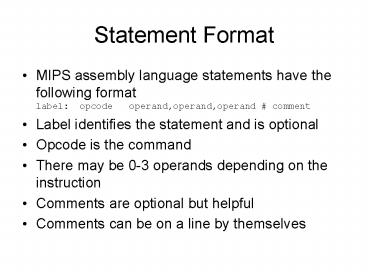Statement Format PowerPoint PPT Presentation
1 / 15
Title: Statement Format
1
Statement Format
- MIPS assembly language statements have the
following formatlabel opcode
operand,operand,operand comment - Label identifies the statement and is optional
- Opcode is the command
- There may be 0-3 operands depending on the
instruction - Comments are optional but helpful
- Comments can be on a line by themselves
2
Register Conventions
- MIPS assembler does not IMPOSE these conventions,
however it does support them. - This way functions can be easily exchanged and
teams can work on a single product - More later
3
Command Formats
- To make sure you use the proper command, look at
the operands and their data type - Some commands take 3 registers as operands
- Some take an actual number (immediate) as one of
the operands - Some take a label (of a variable or statement) as
one of the operands - Some take a memory location specified by a
base/offset pair (Macro assembler allows labels
for the memory location)
4
Arithmetic
- Lets translate xy7-z
- Assembler .text lw t0,y addi
t0,t0,7 lw t1,z sub t0,t0,t1 sw
t0,x li v0,10 syscall .datax
.word 0y .word 0z .word 0
5
Multiply
- Lets look at Brittons appendix C about the
Multiply instruction - It multiplies the contents of two registers
(remember the result can be BIG) and stores the
lower 32 bits of the result in the LOW register
and the upper 32 bits in the HIGH register. - How do we work with HIGH and LOW?
- Move from High mfhi reg
- Move from Low mflo reg
6
Divide
- When we divide, there is a quotient and a
remainder (we are in the integer world) - Again, looking at appendix C, Divide (div) takes
2 registers, divides the first by the second, and
places the quotient in LOW and the remainder in
HIGH - Divide unsigned (divu) treats the values as
unsigned (positive) values. There is a multiply
unsigned (multu) also.
7
Another Expression
- Lets translate the followingxy(x312)/zkx
mod 5 - In assemblerlw t0,xaddi t0,312lw t1,ymult
t1,t0mflo t0should check for overflow in
HIGH
- lw t1,zdiv t0,t1mflo t0sw t0,xli t1
,5div t0,t1mfhi t0 - sw t0,k
8
Basic Branching
- The branch instructions have the
format branchop reg, label - The branchops can be
- bgez - branch if greater or equal to 0
- bgtz - branch if greater than 0
- blez branch if less or equal to 0
- bltz branch if less than 0
9
Equality
- Branch on equality uses op reg, reg, label
- Ops are
- beq
- bne
10
Macro Branches
- The assembler will generate an equivalent set
(1-2) of basic assembler instructions for each of
these - beqz reg, label
- bge reg,reg,label
- bgt reg,reg,label
- ble reg,reg,label
- blt reg,reg,label
- bnez reg,label
- b label
11
Control Structures - If
- if (altb)
- xa1
- yb-a
- aa2
- lw t0,a
- lw t1,b
- bge t0,t1,pos1
- addi t2,t0,1
- sw t2,x
- sub t2,t1,t0
- sw t2,y
- pos1 addi t0,t0,2
12
If else
- lw t0,x
- bgez t0,el
- lw t1,y
- addi t2,t1,1
- sw t2,y
- sub t0,0,t0
- sw t0,x
- b last
- el lw t3,z
- addi t3,t3,1
- sw t3,z
- sub t3,0,t0
- sw t3,y
- last sra t0,t0,1
- sw t0,x
- if (xlt0)
- yy1
- x-x
- else
- zz1
- y-x
- xx/2
13
While
- while (altb)
- aa1
- bb-1
- lw t0,a
- lw t1,b
- rep bge t0,t1,out
- addi t0,t0,1
- addi t1,t1,-1
- b rep
- out sw t0,a
- sw t1,b
14
For
- for (i0 ilt100i)
- sumsumi
- eveneven2
- add t0,0,0 li t0,0
- li t1,100
- lw t2,sum
- lw t3,even
- loop add t2,t2,t0
- addi t3,t3,2
- addi t0,t0,1
- blt t0,t1,loop
- swi, sum, even
15
Macro Instructions
- Instructions in assembler that generate more than
one machine language instruction or a very
different machine instruction than what is
stated. - Allows for smaller and faster instruction set
- Look at Britton, appendix D
- Some are just one statement.

